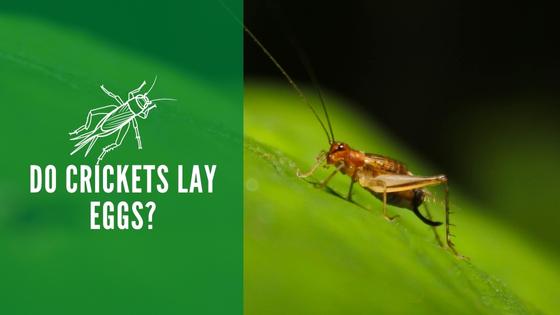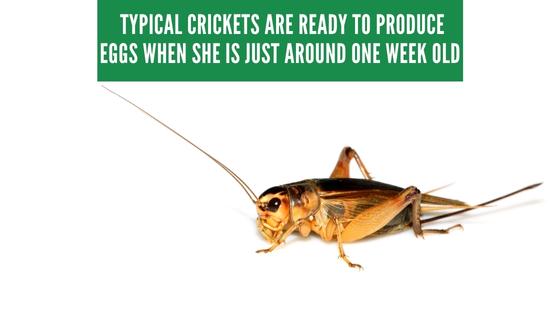Do Crickets Lay Eggs?

Crickets tend to fall into that category of bugs that some people love, and others detest. For some, the sound of cricket is a comforting reminder of time spent outdoors. However, having one’s chirps keep you up all night in your house reminds you of how annoying they get during their mating season.
The simple answer to this question is that female crickets do lay eggs. Yet, knowing when, how, and what this means for controlling them on your property gives you a better understanding of how crickets reproduce.
What Do Cricket Eggs Look Like?
With over 120 species of crickets living in the United States alone, it just makes sense that there can be some variances in the appearance of their eggs. For the most part, a cricket egg looks like a tiny grain of rice, although some eggs can be shaped more like a shorter oval.
Their eggs are usually white or a light yellow color. They can also start translucent and become white as they mature. Some crickets even lay black eggs. Since these eggs can often be confused with ones from other insects, it takes some careful inspecting to be sure what they are.
Where Do Crickets Lay Their Eggs?
Despite their insistent chirping that makes it clear that male crickets are eager to mate, they tend to care less about their future babies. Male crickets are notorious for destroying eggs and feeding on baby nymphs, which is why cricket mothers are very selective about where they lay their future babies.
After mating, a female cricket begins making eggs that she deposits using a special appendage called an ovipositor, which is a tube-like organ on the posterior part of her body. Crickets tend to look for a damp place to lay their eggs near a food source.
Some crickets lay their eggs in or near plant stems, placing them just under a half inch into dirt. Indoors, they’ll lay them in tiny crevices along the walls. They are especially fond of moist spaces where water may drip around a plumbing fixture.
Females will often use the same spot to lay several rounds of eggs. Still, they will relocate them if they suspect they are at risk of being harmed by a predator.
How Many Eggs Do Crickets Lay?
After becoming an adult, a female cricket spends most of her time mating and then laying eggs. On average, crickets will lay about five to 10 eggs each day, but certain species can make up to 100 per day during the height of their reproductive time.
By the time a female cricket has reached the end of her life cycle, she may have deposited as many as 2,000 eggs.
How Fast Do Crickets Reproduce?
A cricket’s life cycle is short, with most insects only living about two to three months. The typical female cricket is ready to begin mating and producing eggs when she is just around one week old. She’ll continue depositing eggs up to the end of her life.

Most female crickets lay eggs every other day for two to three weeks before they need to mate again. Once they mate, they can quickly begin laying eggs again without much of a break.
This rapid reproduction cycle allows cricket populations to grow quickly. Keep in mind; however, that male crickets and other predators can help to cull the new baby nymphs before they reach maturity. However, there is still a vast number of crickets that will survive.
What Do Cricket Babies Look Like?
While cricket eggs can look like ones from other types of insects, there’s no mistaking what a nymph is once it hatches. Cricket nymphs look much like their adult counterparts. They will lack wings and their reproductive organs.
To grow, cricket nymphs go through a series of molts called instars. During their molts, they shed their exoskeleton and emerge as white crickets.
Within a few hours, their exoskeleton will harden, and they’ll return to feeding until it is time to molt again. Usually, a cricket will go through eight to 10 molts before reaching adulthood.
After that, they’ll have their reproductive organs and be ready to start making new babies.
What Is the Cricket Life Span?
The typical house cricket you’ll find living in or around your property lasts about two to three months. A cricket’s life cycle is fairly dependent upon the temperature of its environment.
The ideal environment for crickets to lay eggs, hatch, and live to adulthood ranges from around 80 to 90 degrees Fahrenheit.
Healthy crickets can survive colder weather by finding areas where the temperature is higher, such as inside buildings and near compost areas where the decomposing process can raise the soil temperatures.
Do Crickets Cause Damage?
Outside, crickets mostly feed on plant life, which can pose a problem for people with gardens or farming crops. Inside, a cricket might also choose to feed on natural fabrics that include cotton, silk, and wool.
A single cricket will usually not cause too much damage, and you can rest assured that they are harmless to humans. Crickets spend most of their adulthood breeding and laying eggs, and they aren’t known to cause serious bites or stings.
Most people still prefer to control cricket populations on their property simply because they are a nuisance. Farmers and gardeners won’t want to allow crickets to eat their crops, and large populations can also attract unwanted predators such as snakes and mice.
Indoor control is also important for preventing unwanted pest infestations. Plus, you might prefer not to be serenaded by hundreds of crickets as they perform their mating rituals. Exclusion works well for this purpose. Keeping doors and windows sealed can stop crickets from getting inside, but you may need to take further action if they still manage to get into your property
The sound of cricket often means that there is more than one on your property. That chirping sound is a herald that signifies that mating season is well underway. Whether you love the sound or prefer never to hear it again, you’ll want to investigate if those little crickets could turn into a big problem around your home or commercial building.
Related Posts
Sorry, we couldn't find any posts. Please try a different search.
